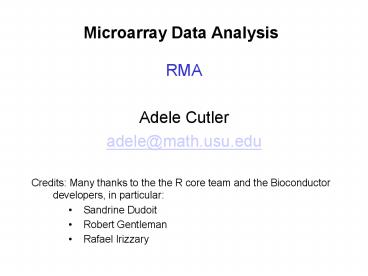Microarray Data Analysis PowerPoint PPT Presentation
1 / 7
Title: Microarray Data Analysis
1
Microarray Data Analysis
- RMA
- Adele Cutler
- adele_at_math.usu.edu
- Credits Many thanks to the the R core team and
the Bioconductor developers, in particular - Sandrine Dudoit
- Robert Gentleman
- Rafael Irizzary
2
RMA Irizarry et al. (Biostatistics, 2003)
- How can we combine the 16 to 20 probe-pair
intensities (PMs and MMs) into a single
expression measure? - Looks at real data, shows that
- The majority of probe-sets have at least one
negative PM-MM. (Bad news for taking logs). Page
6. - MM grows with PM, (Fig 1) so it seems that MM is
capturing some of the signal. (MM is supposed to
just capture nonspecific binding).
3
RMA Irizarry et al. (Biostatistics, 2003)
- For high-abundance probes, the distribution of
log(PM/MM) is bimodal a positive mode (large
PM, small MM) and a negative mode (small PM,
large MM). Fig 1.
4
RMA Irizarry et al. (Biostatistics, 2003)
- There are clear scanner effects if we look at
either PM or PM-MM. Fig 2. We need to normalize! - If we use 2 reps in place of red/green and do MA
plots as for 2-color cDNA arrays, we get similar
pictures to the ones for cDNA. So, normalization
must depend on abundance. - We cant normalize using loess as we did for
2-color arrays (only one color!) so instead we
use quantile normalization. Makes the
probe-distributions the same for all arrays. - Normalization helps to identify genes that are
differentially expressed!! (Fig 3)
5
RMA Irizarry et al. (Biostatistics, 2003)
- Probe-specific effects are additive in the log
scale. Fig 4. - PM-MM shows probe effects, so subtracting is not
enough to adjust for probe differences. Fig 4. - PM/MM attenuates true differences, because MM
responds to signal. So, we will lose power if we
use any measure that depends only on PM/MM. Fig
4.
6
RMA Irizarry et al. (Biostatistics, 2003)
- We must adjust for nonspecific binding and noise,
because if we dont, we will lose power for faint
signals - log(1002s) ? log(100s) if s is small.
- MM looks to have a mixture distribution some of
the MMs do capture noise and nonspecific
binding, while others also capture signal. - Assume signal is exponential and background is
normal ?B().
7
RMA Irizarry et al. (Biostatistics, 2003)
- Let Yij be background adjusted, normalized,
log-transformed PM. Let - Yij ?i ?j ?ij
- ?i is the expression (log scale)
- ?j is the probe effect
- ?ij is noise
- Fit a statistical model to estimate ?i , use this
in subsequent analysis.

